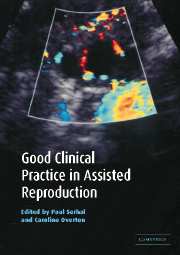Book contents
- Frontmatter
- Contents
- List of contributors
- Foreword by Bob Edwards
- Preface
- 1 Clinical assessment of the woman for assisted conception
- 2 Clinical assessment and management of the infertile man
- 3 Laboratory assessment of the infertile man
- 4 Donor insemination
- 5 Treatment options prior to IVF
- 6 Strategies for superovulation for IVF
- 7 Techniques for IVF
- 8 Ovarian hyperstimulation syndrome
- 9 Early pregnancy complications after assisted reproductive technology
- 10 Oocyte donation
- 11 Surrogacy
- 12 Clinical aspects of preimplantation genetic diagnosis
- 13 Controversial issues in assisted reproduction
- 14 Alternatives to in vitro fertilization: gamete intrafallopian transfer and zygote intrafallopian transfer
- 15 Counselling
- 16 Good nursing practice in assisted conception
- 17 Setting up an IVF unit
- 18 Information technology aspects of assisted conception
- 19 Assisted reproductive technology and older women
- 20 Ethical aspects of controversies in assisted reproductive technology
- Index
- Plate section
5 - Treatment options prior to IVF
Published online by Cambridge University Press: 22 October 2009
- Frontmatter
- Contents
- List of contributors
- Foreword by Bob Edwards
- Preface
- 1 Clinical assessment of the woman for assisted conception
- 2 Clinical assessment and management of the infertile man
- 3 Laboratory assessment of the infertile man
- 4 Donor insemination
- 5 Treatment options prior to IVF
- 6 Strategies for superovulation for IVF
- 7 Techniques for IVF
- 8 Ovarian hyperstimulation syndrome
- 9 Early pregnancy complications after assisted reproductive technology
- 10 Oocyte donation
- 11 Surrogacy
- 12 Clinical aspects of preimplantation genetic diagnosis
- 13 Controversial issues in assisted reproduction
- 14 Alternatives to in vitro fertilization: gamete intrafallopian transfer and zygote intrafallopian transfer
- 15 Counselling
- 16 Good nursing practice in assisted conception
- 17 Setting up an IVF unit
- 18 Information technology aspects of assisted conception
- 19 Assisted reproductive technology and older women
- 20 Ethical aspects of controversies in assisted reproductive technology
- Index
- Plate section
Summary
Introduction
The treatment options that face a couple prior to IVF essentially depend upon the cause of their infertility. The surgical techniques to treat mild or moderate endometriosis will not be discussed here neither will we enter the debate of surgery (open or laparoscopic) versus IVF for distal tubal disease. This chapter will discuss the role of controlled ovarian hyperstimulation and intrauterine insemination (COH-IUI) in the management of mild male factor subfertility, endometriosis and ovulation induction in anovulatory infertility, and will concentrate on the management of unexplained subfertility.
Male factor subfertility
Severe male factor subfertility is treated by intracytoplasmic sperm injection (ICSI) after excluding carrier status for cystic fibrosis and performing a karyotype. However, the point at which a physician should advise a trial of COH-IUI prior to embarking on the more ‘medicalized’ procedure of IVF-ICSI is controversial. A meta-analysis of couples with male factor infertility suggested that the chance of conception with male factor subfertility is half that of other couples with other causes of subfertility after IUI – odds ratio 0.48 after stepwise logistic regression (Hughes et al., 1997). In contrast a prospective randomized trial concluded that COH-IUI was equally effective in couples with male factor infertility and unexplained infertility (Goverde et al., 2000). It is therefore important to define the degree of male factor subfertility because inevitably the cycle fecundity will vary according to the degree of oligoasthenozoospermia. In the prospective study of Goverde et al. (2000), male factor subfertility was defined in couples where three out of five semen analyses showed a total motile sperm count of less than 20 million progressively moving sperm in the ejaculate.
Keywords
- Type
- Chapter
- Information
- Good Clinical Practice in Assisted Reproduction , pp. 100 - 111Publisher: Cambridge University PressPrint publication year: 2004

